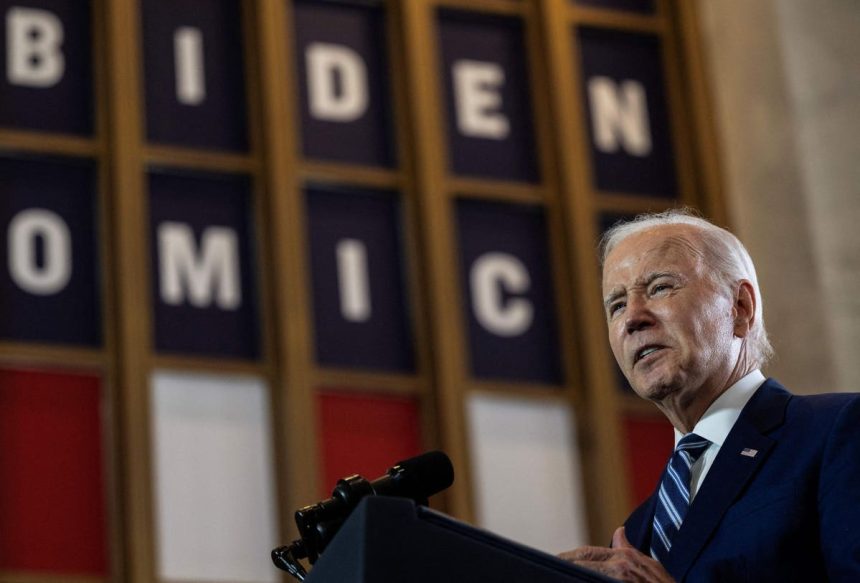Chicago just hosted a widely covered presidential speech. In it, President Biden told Americans that they have a mistaken view on the economy. Although the average of polls shows that only some 38.3% of American voters have confidence in the president’s handling of the economy, Biden thinks he is doing a great job, and in Chicago he told America so. Not only did he insist that things are looking up, but he described for those listening how things will get still better once his policies have a chance to take effect. The talk clearly aims at the 2024 election. It is unlikely that the message will gain acceptance.
Biden has given himself quite a job. His approval figures on economics have deteriorated consistently since he took office. In March of 2021, just after Washington’s second pandemic relief bill became law, some 60% of American adults thought Biden was doing a good job on the economy. That was the high point. Soon thereafter, especially as signs of inflation began to emerge, his approval ratings began to fall, and they have done so consistently since, down to the recent poor showing.
Despite this public judgement, Biden in his Chicago speech took full ownership of his administration’s economic stewardship, referring to it as “Bidenomics.” The economic symphony he composed there had four movements. The first took up the still-strong jobs market. In May payrolls grow by a strong 339,000, even faster than the already impressive figures recorded in previous months. Unemployment, though up slightly to 3.7% of the workforce, is still remarkably low by historical standards. The speech’s second movement used the upbeat jobs theme to point out how the economy has avoided the recession once widely anticipated in response to the Federal Reserve’s (Fed’s) anti-inflationary interest rate hikes. The third movement then dismissed inflation fears. The president noted that the pace of inflation has come down dramatically from the highs of a year ago. At a 4% annual rate, it is less than half what it was in June of 2022.
The final, fourth movement in the presidential composition took a dramatic prospective tone. Here the president claimed his policy of targeted investments would move the economy forward much more effectively than tax cuts would. He gave as illustrations last year’s bipartisan infrastructure bill and his legislation to subsidize the domestic manufacture of semiconductors as well as the recently announced $40 billion to bring high-speed internet to the entire country. These steps, he insisted, will pay great dividends, though he admitted that the effects will take time to materialize.
For all this, there remain other economic indicators, not mentioned by the president, as well as different economic perspectives that might explain Biden’s low economics rating, despite the speech’s framing. A crucial negative, and one that Americans cannot help but note, is the state of real wages. Weekly and hourly paychecks have increased, but they have failed to keep up with inflation. Hourly earnings after the effects of inflation have declined more than 3% since Biden took office. Meanwhile, other important economic indicators show inordinately slow growth if not signs of outright recession. The country’s real gross domestic product (GDP) increased barely 2% at an annual rate during the year’s first quarter, far less than historical averages. Consumer spending – a crucial two-thirds of the economy – increased at only a 0.8% annual rate in real terms during the three months ended May, the last period for which data are available. Homebuilding, though up recently, has declined nearly 13% over the past year. This kind of news inspires neither confidence among households nor does it point to an engine of growth.
If Biden’s speech is an early glimpse at the 2024 election campaign – and that is certainly what it looks like – it constitutes a high-risk strategy. The election, after all, is 16 months away. For his economic perspective to gain traction, the economy will have to improve visibly over the intervening months. But the Fed has indicated that it is determined to raise interest rates in coming months and at the very least keep them high until inflation retreats to the preferred 2% rate, half today’s ongoing rate. That promises high and possibly rising rates for quite some time yet, a policy stance that if it does not guarantee recession hardly points to an economic pickup. The president also has effectively promised continued improvements in inflation. History shows, however, that inflation typically follows a variegated path and will almost surely show signs of worsening at some point during this time. Nor are wages likely to catch up to inflation any time soon. Things could of course work out, but the likelihoods still suggest that things will deteriorate before they improve. The president seems to have already placed his bets otherwise.
Read the full article here










